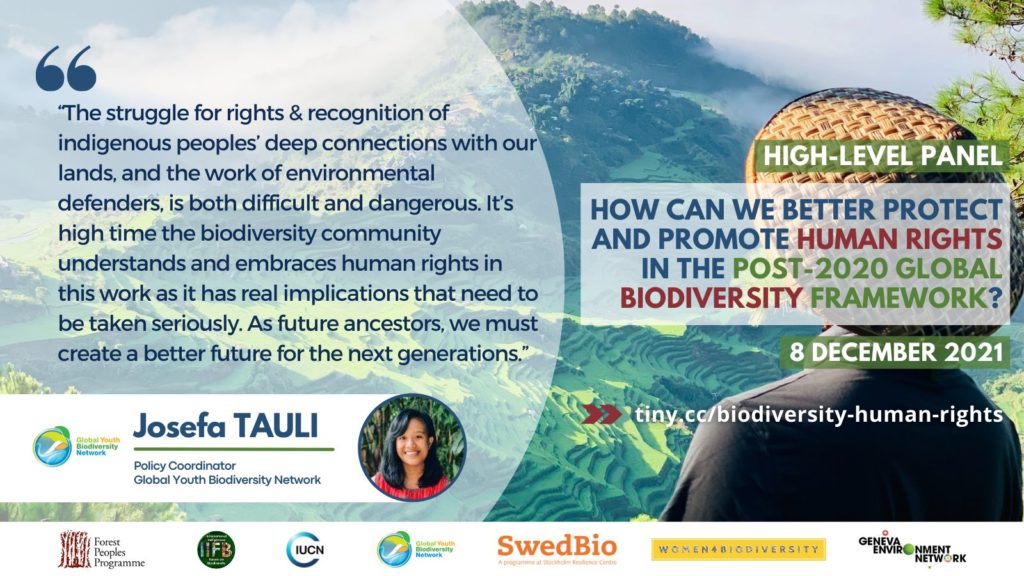Événement Virtuel
How Can We Better Protect and Promote Human Rights in the Post-2020 Global Biodiversity Framework? | High-Level Panel
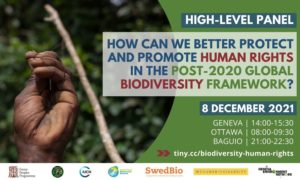
08 Dec 2021
14:00–15:30
Lieu: Online | Zoom
Organisation: Forest Peoples Programme, SwedBio, International Indigenous Forum on Biodiversity, Global Youth Biodiversity Network, Geneva Environment Network, Union Internationale pour la conservation de la nature
This high-level event, co-convened by Forest Peoples Programme, Swedbio, the International Indigenous Forum on Biodiversity (IIFB), the Global Youth Biodiversity Network (GYBN), IUCN, Women 4 Biodiversity, and the Geneva Environment Network aimed at drawing attention to the importance of human rights in the Global Biodiversity Framework prior to the final face-to-face negotiations of the post-2020 Global Biodiversity Framework.

About this Session
Respecting and protecting human rights and protecting the environment are inextricably linked, as recently confirmed by the Human Rights Council resolution 48/13 on the right to a clean, healthy, and sustainable environment. Yet while Heads of State from 93 countries have called to end siloed thinking in the Leaders Pledge for Nature, and global civil society has stated the same in no uncertain terms, environmental policy making still too often excludes or side-lines human rights. This Panel will reflect on the important opportunity of changing this history in the context of the Convention on Biological Diversity’s Global Biodiversity Framework to be adopted early in 2022, and bringing human rights into the new framework both as a guide to do no harm, and as a beacon for ways to do things better. Specific opportunities to realise this will be presented by speakers.
The event was simultaneously interpreted into Spanish and French, recorded, and a summary of key recommendations for the text negotiations will be provided afterwards.
Speakers
By alphabetical order.

Shruti AJIT
Women 4 Biodiversity

Ramiro BATZIN
Co-Chair of the International Indigenous Forum on Biodiversity (IIFB) | speaking in Spanish
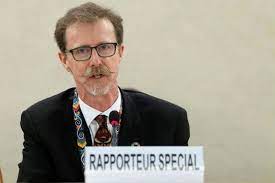
David BOYD
UN Special Rapporteur on Human Rights and the Environment (pre-recorded video)
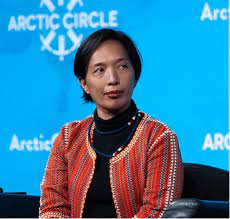
Jennifer CORPUZ
Senior Global Policy and Advocacy Lead, Nia Tero

H.E. Amb. Catalina DEVANDAS
Permanent Mission of the Republic of Costa Rica to the United Nations Office and other international organizations in Geneva

Wolfram MORGENROTH KLEIN
German Federal Ministry for Economic Cooperation and Development (BMZ)

Josefa TAULI
Policy Coordinator, Global Youth Biodiversity Network

Basile VAN HAVRE
Co-Chair of the Open Ended Working Group on the post 2020 Global Biodiversity Framework

Helen TUGENDHAT (Moderator)
Environmental Governance Coordinator, Forest Peoples Programme
Video
Subtitles are currently being processed by the organizers and will be added soon.
Summary
Welcome and Introduction
Setting the Stage | Helen Tugendhat, Forest Peoples Programme

- Speakers today will discuss how we can enhance and promote human rights in the post-2020 Global Biodiversity Framework (GBF). They go through the current status of the negotiations towards the GBF and will present a range of concrete, practical ways in which human rights could be better integrated into it.
- Despite the uncertainty it faces at the moment, it is more important to press forward with discussions. As we move towards the next round of negotiations, the momentum towards finalizing the framework grows again, despite the enormous challenges that the pandemic has thrown up: for civil society actors and indigenous peoples to participate, for State Parties to negotiate effectively, and for the document to be advanced in a form fit for the challenge we have before us.
- This panel has been designed to be supportive of these coming negotiations, and we will be hearing not only a framing of where negotiations are, but also concrete ways in which the language can be advanced or enhanced with respect to human rights.
Traditional knowledge provides resilience to a changing climate | Video
Panel Discussion
Strengthening Human Rights in the Global Biodiversity Framework | Basile Van Havre, CBD
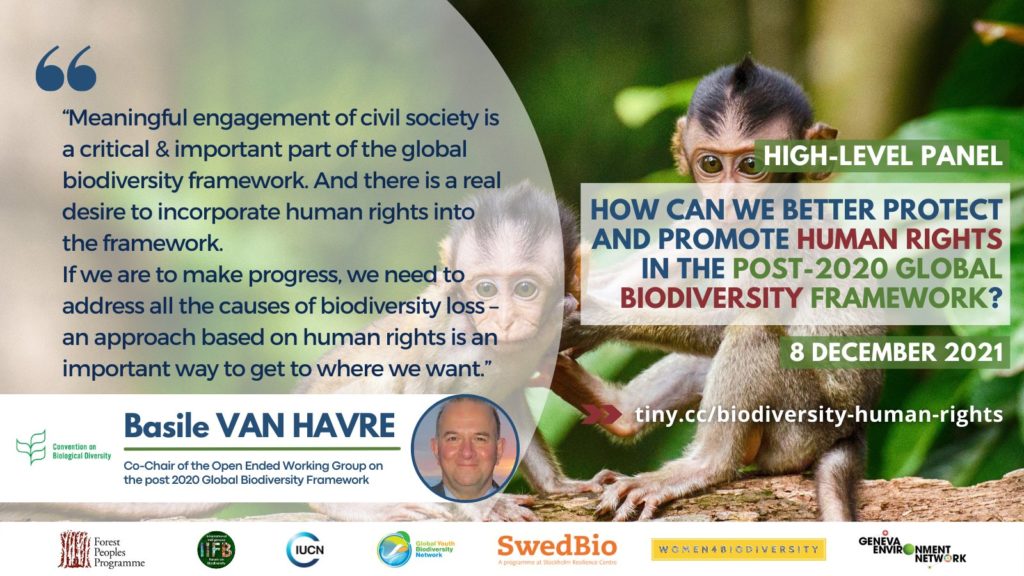
- It is important to keep in mind that my role is coordinating and guiding the process. So I am trying to stay neutral, ask questions, and point people to the consequences of what they will choose. But in the end, it’s up to the parties and stakeholders that will make the framework.
- Regarding the process:
- The delays of the process has been very tough for the staff, but that’s the way it is, and we will continue. We’re planning for an Open-Ended Working Group (OWEG) beginning in March. There will be some slight delays in the COP15, but the intention is to keep it in the first half of the year.
- Another point regarding the process is that people want to have civil society present to engage in discussions. There is desire to ensure that there is an appropriate place for meaningful engagement in our process. As I’ve heard from the delegation present at the UNFCCC COP26 in Glasgow that civil society’s role was important and critical, even though it wasn’t perfect. We’re going to try to do better.
- Regarding the substance and the outcome of the framework:
- A document was recently published to support the upcoming meeting of the OWEG. The Reflections by the Co-Chairs is a document that tried to summarize what we have heard and seen in August during the informal online discussions. It also provides some reflection and questions to guide the preparation work, and in some cases, some new language.
- The issue of human rights came repeatedly in many targets. There was a real desire to make that preeminent in several places. What we’re suggesting in that document is the creation of a new section upfront in the framework. Avoiding the term “principles” as suggested by legal advisors, the section is called “guidance for implementation” (see III.B.17), where out of the seven points of guidance, two are related human rights. Human rights is the only issue that receive attention in two points, and we wanted to put that in a very prominent place upfront, right before the Vision, Mission, and Goals, to enable to have it present throughout the document.
- I would be interested in receiving your views on this matter: What do you think about the way we have characterized the human rights issue on the new section? What do you think about the idea of having a new section with some principles that talk about gender, the role of indigenous people and local communities, the role of human rights in a way that is clearly tied to the overall framework?
- Once again, we were trying to create the framework for all, as a whole and not piecemeal. If we are to progress on this biodiversity crisis, we need to address all the causes of biodiversity loss, both the direct one and indirect one. There is no other choice. You have to plug all the leaks in the boat if you want to stay afloat.
- Definitely, this notion of having an approach that is based on rights is an important way to get the results that we want.
Youth Priorities for the Development and Implementation of the post-2020 Global Biodiversity Framework | Josefa Tauli, Global Youth Biodiversity Network
- I will start by sharing that this crucial topic of human rights as they interrelate with biodiversity is something that bears a lot of personal weight. I come from a family whose members, through the decades, have been very much involved in the struggle for Indigenous Peoples rights and the recognition of our deep connections to our lands. The work of environmental defenders is very important work, but I have also witnessed how this work on the front lines of an ecological crisis is not just difficult but it’s also in many cases very dangerous. It’s high time that the biodiversity community actively understands this and embraces human rights issues in this work, because it has very real implications that needs to be taken seriously.
- Speaking as part of the Global Youth Biodiversity Network (GYBN), which represents youth voices in CBD processes, we have put in efforts to engage with the post-2020 GBF process from the beginning. From the broad consultations the GYBN has conducted, three priorities have come up:
- First, intergenerational equity and the full and effective participation of the youth.
- For us, the stakes in these decisions are very high. Even now, we are already carrying the burden of the impacts of biodiversity loss and climate change. Children and youth experience heightened health risks and are often sidelined in decision making processes that directly impact us.
- However, we are also key implementers on the ground. We are leading change with our own hands, often with very limited resources. As such, in the post-2020 GBF, we are demanding the recognition of intergenerational equity, including the rights of younger and future generations to be able to live in a healthy environment and to participate in the decisions that affect us.
- This means, recognizing intergenerational equity as an enabling condition. It means respecting the precautionary principle, if there is a risk of irreversible damage to nature and people. It means ensuring that the solutions planned and implemented truly work for the long term. And it also means actively supporting youth-led initiatives.
- Second, quality transformative education that can foster generations that live in harmony with nature.
- Quality education is a human right. We believe that it is a very strong tool in addressing many of the indirect drivers of biodiversity loss. This is something that can really create long lasting change.
- For the GBF to reflect this, we believe that including language on integrating biodiversity, into formal education curricula would be very powerful, either in the targets or in the implementation mechanisms.
- This can really empower the education sector, to be key actors in this framework for all, but the GBF should also support the other but non-formal education initiatives. This would empower youth all over the world who already have a lot of incredible initiatives on transformative non-formal biodiversity education.
- Third, having rights-based approaches for people and nature more broadly.
- We need to secure indigenous peoples’ rights, lands, and resources, and our rights to free, prior, and informed consent (FPIC).
- We need to ensure access to justice and create strong accountability mechanisms for human rights. Moreover, we need to ensure that resources are flowing directly to the ground, especially to indigenous peoples and local communities, women, and youth.
- We also need to ensure support and protection for environmental defenders, among others.
- For the youth, we believe that the post-2020 GBF should integrate elements on again intergenerational equity, education, and human rights, including children’s rights. From our assessment, it’s lacking in this regard and we hope that moving forward, negotiations can remedy this so that we can genuinely address the root causes of biodiversity loss, as we are future ancestors creating a better future for the next generations.
Opportunities for Improvement of the Post-2020 Biodiversity Framework Draft and Priorities for Costa Rica | H.E. Amb. Catalina Devandas
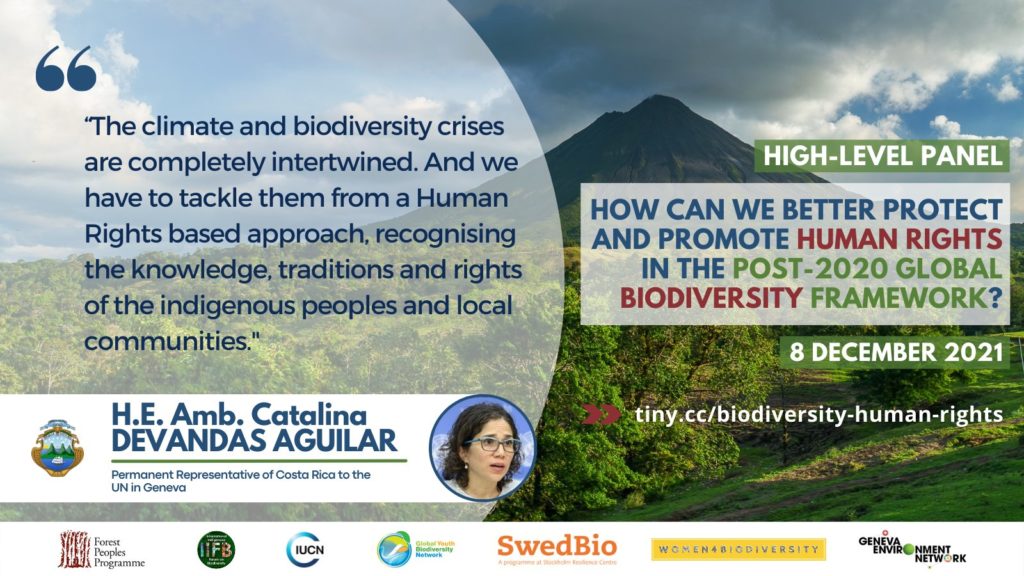
- The protection of biodiversity and indigenous peoples are two areas that are fundamental for Costa Rica: it’s part of our foreign policy as well as our national efforts. Our aim is to bring these efforts together.
- The crises that we are experiencing are completely interconnected; the climate crisis and the loss of biodiversity directly affects the application of human rights.
- As a country, Costa Rica has a great responsibility to deal with these crises in a holistic way, considering a human rights-based approach. We need to do this as much as through international, high-level agreements as through national agreements, with both focused on reducing the deterioration of biodiversity and to promote and maintain our current biodiversity to improve the enjoyment of human rights.
- On the 30×30 target
- In respect to the coalition, we are advocating for the goal to protect at least 30% of the land and oceans by 2030. We are conscious of the challenges, and along with the 77 countries that support this goal, we hope and trust that this goal will be achieved through the respect of human rights.
- This means with the inclusion, participation, and association of indigenous peoples and local communities, recognizing that their cosmovision and their traditions are perhaps the most valuable tool we have to ensure the conservation and sustainable use of biodiversity.
- The coalition is also aware that many indigenous peoples have expressed concern that reaching this goal could affect their rights, especially their rights to land. For this reason, we created a specific working group that coordinates with indigenous peoples’ representatives (like the International Indigenous Forum on Biodiversity) with the aim of maintaining a constant dialogue and ensuring that the final text reflects their concerns.
- We have created a document with the IIFB that includes the vision of both the Coalition and indigenous peoples on the role that indigenous peoples and local communities should play in the goal of protecting 30% of our biodiversity. Our objective is clear – we must ensure that both the commitments and the language adopted are clear and concise in the respect of human rights.
- On the High Ambition Coalition for Nature and People
- It’s extremely urgent to move forward with the commitments of the High Ambition Coalition. We have got the opportunity to create clear and ambitious goals and objectives to stop this crisis and put nature on the road to recovery. This is why we need to ensure that this framework has a human rights perspective. We must recognise the essential role of indigenous peoples, as well as the participation of women, young people and other groups that face exclusion and marginalisation, in the protection and conservation of biodiversity.
- Costa Rica is advocating for the post-2020 Global Framework to include a specific goal focused on gender, and in this way we can ensure that there is an equal access to the benefits of biodiversity, as well as guaranteeing the participation of women and girls in the decision-making process.
Priorities for Biodiversity Negotiations with regard to Human Rights | Ramiro Batzin, IIFB

- The critical issues and the key issues that indigenous peoples have been raising is a reflection with all the analyses that the International Indigenous Forum on Biodiversity has been carrying out during this period
- The key themes that we must recognise are
- The recognition of land, waters, territories, resources and conservation
- The customary sustainable use of biological diversity
- Equitable access to and distribution of benefits
- Traditional Knowledge
- Equitable participation and governance
- Climate change
- It is important to look at each of the goals. Regarding Target 3 or the 30×30 target:
- The majority of biodiversity in the world is found in indigenous lands, territories and waters, which is a proof of effective management of biodiversity
- It’s necessary to guarantee Free, Prior and Informed Consent (FPIC) of indigenous peoples to guarantee respect for human rights
- Indigenous peoples, land, territories and waters and different from protected areas and/or other effective conservation measures based on areas, and they cannot be limited to these categories.
- We propose that Target 5 – Customary sustainable use – should be respected.
- This must be respected. We cannot continue denying indigenous rights when they have been international recognized.
- Customary and sustainable use has been declared illegal and is criminalized in many countries, and indigenous people and local communities are often excluded from decision-making on the definition of what is sustainable, legal and secure.
- There is a need to guarantee the respect of customary rights and the customary sustainable use of biodiversity to guarantee respect for human rights. Only in this we can we guarantee human rights and be able to have a balanced conservation system.
- Target 20 – Traditional knowledge
- It’s a positive that they have included Free, Prior and Informed Consent.
- Technical knowledge should also guide a culturally appropriate sustainable development
- Indigenous people have their own vision on the use and conservation of natural resources, and the post-2020 GBF should include indigenous biodiversity management as a central focus.
- Target 21 – Equitable participation
- Positives: they have aligned the language with the UNDRIP. Indigenous peoples propose that the minimum basis of recognition should be the declaration because it has already been approved and we have to stay in that line.
- It’s much clearer that the rights to resources are for indigenous peoples and local communities only.
- Equitable participation is more inclusive, as it also mentions women and young people. This is especially important now as we must recognize and promote the role of women and young people in conservation, but also of the passing down of traditional knowledge.
- The participation of young people today is not to be left for tomorrow, it is for them to take on leadership and conservation roles today.
- The post-2020 GBF has the opportunity now to clearly advance the rights of indigenous peoples, and this will allow true biodiversity conservation and reduce the impacts that we are seeing now from climate change and the COVID-19 Pandemic.
Germany’s Priorities for Integrating Human Rights in Environmental Agreements | Wolfram Morgenroth Klein, BMZ
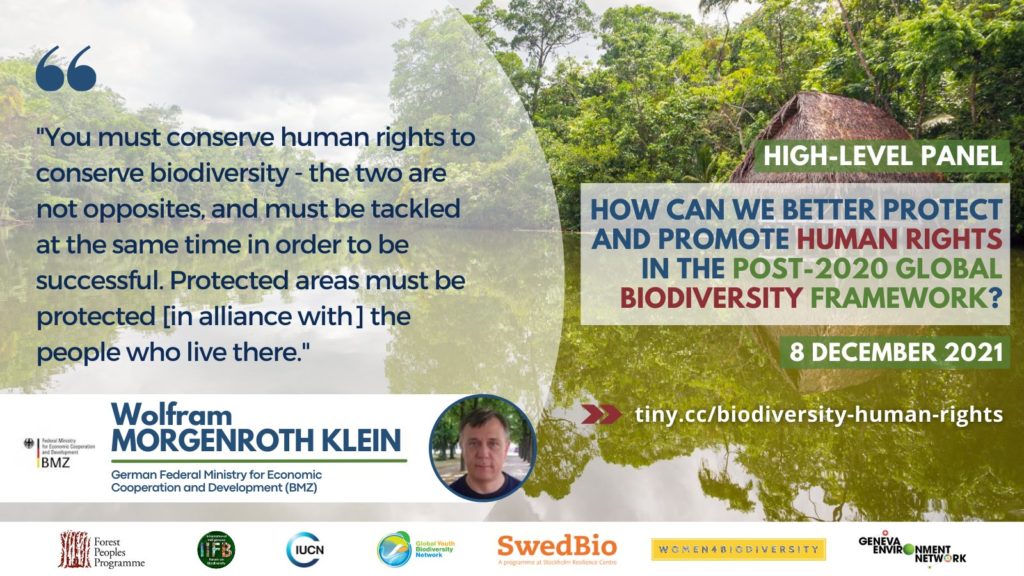
- To begin, I have three thoughts.
- First, nature has inhabitants, there are hardly any nature and protected areas without inhabitants, and this will be even more so if the CBD COP decides on the 30×30 targets in increasing the protected land areas, which I hope they will do. This also means that we will have much more inhabitants in protected areas and we have to think about it.
- Second thought, biodiversity protection and preserving human rights of those people living in or near the protected areas are not opposites. You can do both at the same time, and you will have to do both at the same time, if you want to be successful. The community does service to the country and to humanity by preserving nature.
- Third thought, it is becoming increasingly important that services are being provided, with the climate crisis, biodiversity crisis, and water crisis. I would hope that in the near future an increasing part of these ecosystem services – carbon sinks, nature based solutions, water protection provided by protected areas and the inhabitants – will have mechanisms on how to make them benefit. We from industrialized countries and the middle class should contribute to this ecosystem services by paying something. We are not yet there but I hope this will happen in the future.
- Finally, dialogue and the possibility for individuals and groups to express their concerns should not be just a one-time event. It’s not just the free, prior, and informed consent but there also has to be a permanent mechanism established.
- Therefore, we believe that in almost all cases we need to think much more about grievance mechanisms and outreach for people at a local level in projects financed by development cooperations all over the world in natural protected areas.
- To add a couple of more points we’re trying to push forward as BMZ: As mentioned, we support this 30 by 30 targets at CBD as the whole of the High Ambition Coalition does (We’re very grateful to countries like Costa Rica and France that they have launched this). We support to better include indigenous territories into protection and sustainable use schemes within the CBD. This also includes recognizing more of the indigenous territories officially. After long discussions within the country, Germany has also ratified the ILO Convention 169 this year.
- We support also the COP26 and the climate change decision on Forest Tenure Pledge. We financially support the development of a discussion paper on the integration of human rights into the GBF, in cooperation with the Asia Indigenous Peoples Pact, and the Forest Peoples Program.
- We are advocates to substantially increase, maybe even double the international official development aid for biodiversity in the framework of what is going to happen hopefully at the COP15 in Kunming or elsewhere.
Harnessing Support from States and Civil Society for Protecting Indigenous People’s Rights | Jennifer Corpuz, Nia Tero

- I appreciated that the last speaker ended on the issue of the linkage between biodiversity and climate change, as well as the issue of finance for both biodiversity and climate change action. My organization, Nia Tero is part of the pledges that were announced in recent months, the Forest Tenure Pledge and the Protecting Our Planet Challenge, a 5 billion pledge to support 30×30.
- In terms of them harnessing support from States and CSOs Nia Tero has two approaches:
- The first approach is to support and enable indigenous peoples express their positions. We’ve been supporting the IIFB so that they can have the time to develop their technical capacity to engage. We’re very pleased that the IIFB has been in consistent dialogue with the High Ambition Coalition, and discussions have been very productive.
- Second, we also have evolved mechanisms to discuss with other major groups on how to mutually reinforce positions. Human rights is one of the key issues that has been identified by the major groups, and we support each other: the youth, the women, the CBD Alliance have been supporting each other in relation to human rights.
- With regards to substance: For indigenous peoples, it has already been mentioned that Target 3 is very important, and there are two elements that we really want to see reflected. First is the notion of free, prior, and informed consent, as well as the appropriate recognition and support for lands, territories, and resources of indigenous peoples, or what is beginning to be known as the “tripartite approach”. We have protected areas. We have other effective conservation measures. There should be another category, which would allow indigenous peoples in their customary approaches to territorial management to also be recognized as a distinct approach. Recent studies, including a study published in Nature on irrecoverable carbon has been making this distinction as well: protected areas, indigenous territories, among others, as distinct categories that protect irrecoverable carbon.
- To directly address Basile’s question (placing human rights upfront in the GBF): I think the proposal is good, in the sense that it’s really good to have principles that highlight the need for a human rights-based approach. However, I think that it should be coupled with specific human rights language in very important key priority targets, such as Target 3.
- In recent discussions, there have been several ideas raised. The first is to have human rights in the language of the target itself. The second could possibly be a footnote approach. The third approach could be an indicators approach. I think these three approaches are not mutually exclusive.
- Historically, the program of work on protected areas has already addressed FPIC, in relation to displacement or as a result of the establishment of protected areas. I think it wouldn’t be too complicated to extend FPIC to the establishment of protected areas. This program of work was adopted in 2004, when the UN Declaration of the Rights of Indigenous Peoples (UNDRIP) was not yet formally adopted by the UN, and I think the notion of when FPIC applies to indigenous peoples has to be updated to be consistent with the UN Declaration. The conclusion is that there should be human rights, particularly free, prior, and informed consent, specifically mentioned in the language of Target 3.
- We also hear some comments that maybe an overarching principle would be sufficient. We want to recall the history that Target 18 was supposed to be cross cutting and the notion of equity in Target 11 on protected areas includes the notion of equity. However, it has not been well implemented as we hear continuous cases of violations of indigenous peoples’ rights in the name of establishing protected areas.
- Finally, going through my last three points:
- Indicators are important, and I said that the approaches – footnote, targets, and indicators – are not mutually exclusive. There have to be robust indicators, and land tenure for indigenous peoples is an indicator that needs to be reflected in order to have a strong human rights-based approach.
- A target on the protection of human rights defenders would also be very important, as well as a robust accountability mechanism to address instances of violations and non-compliance with human rights-based approach.
- Lastly, on the notion of biodiversity finance. As mentioned, that we are part of different pledges as Nia Tero. It’s important for those pledges as well to have principles as well as a grievance mechanism for when principles committing to respect indigenous rights are not upheld.
Women’s Caucus Propositions for the post-2020 Global Biodiversity Framework | Shruti Arjit, Women 4 Biodiversity
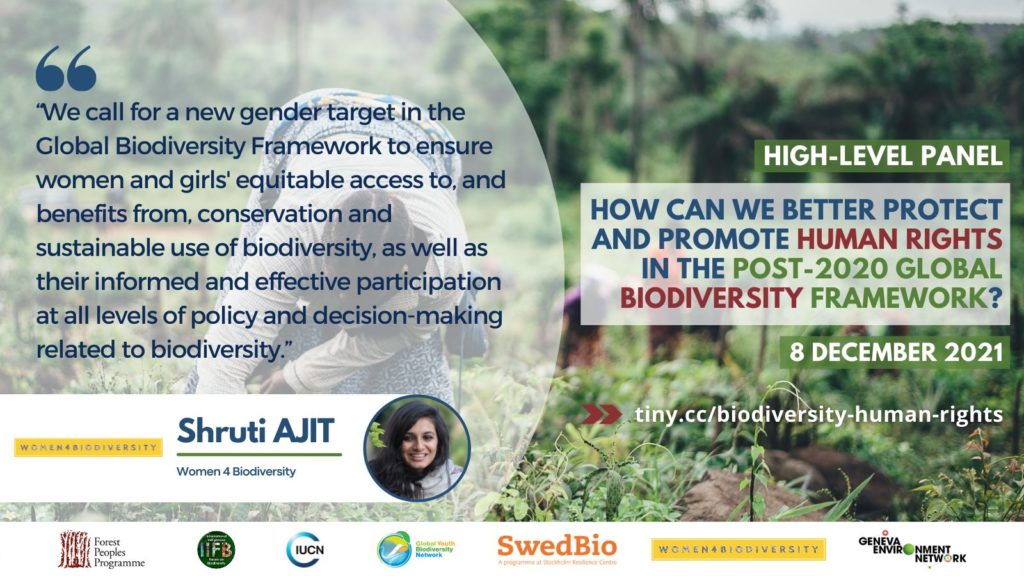
- As a member of the Women Caucus engaged in the UN CBD, we’ve been part of the human rights working group, and we’ve been contributing towards its outcomes thus far. The recent UN Human Rights resolution on the right to clean and healthy and sustainable environment is needed, especially for women and girls who are the most marginalized from biodiversity loss.
- Coming from a country which abstained from this right, this means that we still have people in my country still fighting every day for this basic right. I’ve consistently been threatened to be killed, harassed consistently, for defending and resisting any kind of destruction to their territories of life.
- The co-chair had spoken about the reflection paper which we are able to respond to. The reflection paper has included the word gender sensitive into Target 21, and have also mentioned that “respecting the rights of indigenous peoples and local communities and providing opportunities for equitable and effective participation of indigenous peoples and local communities and women, girls and youth are foundational guidelines of the framework.”
- While we welcome these in Target 21, these changes are not enough to ensure dignity to women and girls who are most impacted by climate change. This is not something which would address generations of marginalization, oppression, and environmental degradation that women and girls will be facing.
- With respect to the reflection again, it also proposes a question for consideration by parties and stakeholders, “Do parties prefer to have a separate target related to gender?” We propose that yes, we do need a standalone target that is gender responsive, recognizes the roles, contributions and aspirations of women and girls for the next 30 years, so that we are able to even be able to realize their basic right to a clean, healthy and sustainable environment.
- With regards to the Target 22, it was proposed in the 3rd Open Ended Working Group, and was supported by Malawi, Colombia and Costa Rica. It is crucial that the target is retained in the GBF, so that it ensures synergies that is cross cutting across the framework, as well as in the post-2020 general plan of action.

- A few things things to think about and facts coming from various reports:
- A recent article on COP26 negotiations in Glasgow mentioned something very interesting. While negotiations are happening inside, the outside was being led by young women and young girls who are taking center stage of the climate change movement. I’m so glad we have Sefa to be part of this panel, who is a classic example of young person talking about climate change, as opposed to negotiations somewhat being only decided by the global north.
- On why there are so many young women and women in general who are talking about climate change so much. This is an indicator of the fact that the impact of biodiversity loss has marginalized communities, specifically women and girls.
- Another report by MSI Reproductive Choices shows that 14 million women are at risk of losing their reproductive choices in the next decade due to climate related disruptions, which is a very scary thought.
- In terms of decision making, the UNFCCC Fact Sheet had mentioned that gender parity in climate leadership will only be achieved in 2068, which is much longer than the scope of even this framework. Studies have also shown that either increase incidences of sexual violence and women due to climate change.
- With all these facts, and things to ponder over, I have a question and a request. Why are we still hesitating to see a standalone target on gender when we have been very aware of this historical and contemporary injustices that women face due to ecological destruction, exclusionary conservation, and biodiversity loss? The Women Caucus have been pushing for this for a while, and hopefully in the future negotiations, we will see more allies who believe in the same vision that we have.
How to Improve the Global Biodiversity Framework to Protect and Promote Human Rights | David Boyd, UN Special Rapporteur on Human Rights and the Environment (Video message)
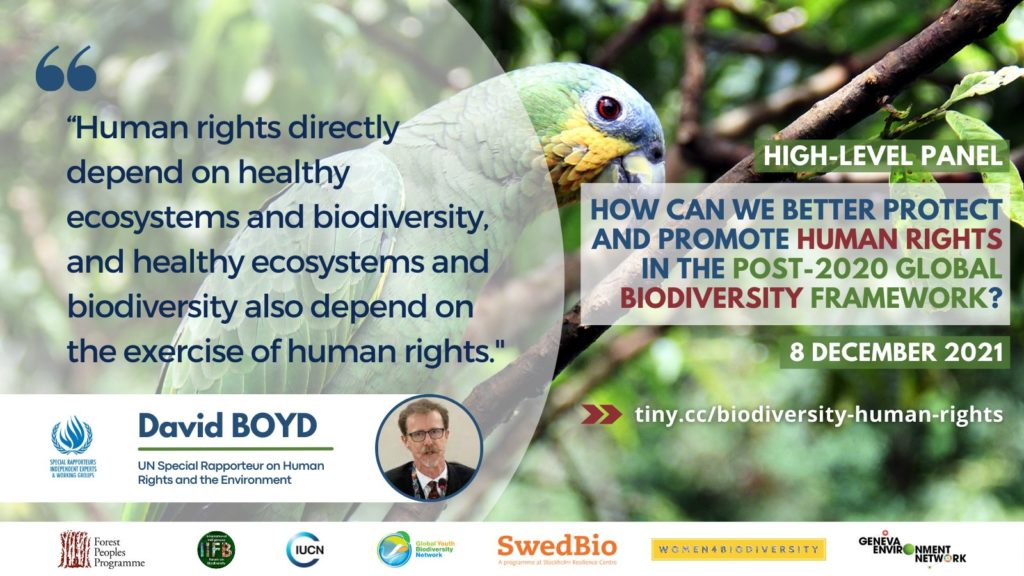
- Human rights depend on healthy ecosystems and diversity, and healthy ecosystems and biodiversity also depend on the exercise of human rights.
- I want to share a story that I heard from a teacher in St. Vincent and the Grenadines, who was in a preschool when a major hurricane struck the Grenadine Islands in 2004. That preschool fortunately was located directly beside an area of healthy mangroves which tamped down the storm surges and they diffuse the wind. The teacher believes that the lives of children in that preschool were saved by the healthy mangrove ecosystem. That’s just one example of many, many ways human rights and healthy ecosystems are intertwined.
- We know that in the past, our failure to take a rights-based approach to conservation has resulted in significant human rights violations: evictions of people from national parks, violence, even murder of people trying to simply have access to lands and waters that they have for centuries relied upon.
- Perversely these approaches to conservation that have not put human rights front and center have failed to achieve the conservation goals. We’ve seen a series of targets for conservation, that have not been met over the past 30 years, despite the presence of the Convention on biodiversity.
- On the other hand, when we do take a rights-based approach to conservation, we get win-win outcomes. These rights-based approaches are more effective, more efficient and more equitable as we’ve seen in countries as diverse as Costa Rica, Namibia, and Slovenia.
- There are three essential things that must be in the post-2020 Global Biodiversity Framework.
- The first is recognition that everyone everywhere, has the right to live in a clean, healthy and sustainable environment. We’ve already seen examples from around the world where people on the ground, indigenous peoples, local communities, peasants, rural women, rural youth, Afro descendants have used the right to a healthy environment to achieve positive conservation outcomes. That right to a clean, healthy and sustainable environment was just recognized by the UN Human Rights Council on 8 October, so it’s essential that we incorporate the this into all the future agreements to protect biodiversity, limit climate change and address pollution.
- The second thing that we need to do is make sure that we’re not merely paying lip service to the rights of indigenous peoples, Afro descendants, peasants, rural women and rural youth. This is critical because the post-2020 GBF needs to not just mention these rights, but advance them. To do so means putting an emphasis on securing the land, water title, tenure and other resource rights of these indigenous peoples and other rural rights holders.
- The third critical thing is that we are going to see an influx of finance, the likes of which we’ve never seen before. Hundreds of billions of dollars are going to be invested in conservation and restoration of biodiversity and ecosystems in the years ahead. We need to ensure that we have safeguards in place. I would argue that the post-2020 GBF should require human rights impact assessment when there’s any proposal for a new Protected Area, be it a terrestrial or a marine protected area or an investment of a substantial amount of money going into conservation. The projects that are the subject of that finance should be streamed to ensure that they are not only compatible with human rights but are advancing the human rights of affected people. We do environmental impact assessments for developments to make sure that we’re protecting the environment. We need to recognize that we need to do the same thing with human rights impact assessments in the conservation realm.
- This is really important work that you are doing, and I look forward to continuing to work together to bring in the strongest and most rights-centered global biodiversity framework that we possibly can.
Discussion
Q: I would love to know more about your thoughts on transformational education from the lens of indigenous peoples.
- Josefa Tauli, Global Youth Biodiversity Network | I believe education overall should recognize the value of indigenous knowledge and should support its respectful and self-determined transmission from generation to generation. Many communities are facing the erosion of their knowledge systems, and so education should be culture-rooted, available in indigenous and local languages, and should support the learning processes that work best for traditional knowledge which often means observation, participation, learning from families, and learning by doing (rather than formal education), among others.
Q: On indigenous languages and intangible voices that are rooted in Mother Nature, ecosystems and biodiversity, are these incorporated in a human rights-based approach? There has also been a lot of discussion about integrating human rights-based approach into the GBF. What would the human rights-based approach mean in practice? How would this change the way the GBF is written or negotiated?
- Jennifer Corpuz, Nia Tero
- Yes. When we talk about the human rights-based approach, it takes into consideration human rights principles that are already contained in the different treaties. One of the provisions is the right to culture, which is reflected across many different treaties, which includes the right to language. These substantive rights would be included in the approach.
- To secure indigenous languages and the cultural values, that underpin indigenous management of resources, as already included in rulings of different human rights bodies, it would be important to ensure the tenure of indigenous peoples over their lands are recognized and protected. The land is the material basis of the culture and language.
- The way that the human rights-based approach would look in practice, would be the strengthening of, then your rights of indigenous peoples which would lead to protection of languages as well as production of values and culture.
- Josefa Tauli, Global Youth Biodiversity Network
- For us, that would mean think in the longer term in thinking about the solutions, making sure we carry out actions that are not just for the next few years, but go much further into the future. It also means ensuring direct financial support for communities who are key implementers. It means supporting the leadership of indigenous peoples, local communities women and youth as key implementing partners, and not just beneficiaries of support. To be able to lead our own initiatives. It means securing land rights for indigenous peoples and pursuing genuine recognition of free, prior, and informed consent, and self-determination.
- Ramiro Batzin, IIFB
- Yes, it is very important to look at the issue of the human rights approach. We are talking about the issue of human rights, but for indigenous peoples it has to be the issue of the human rights of indigenous peoples. We have to see those fundamental collective rights of indigenous peoples. It is key to see the system of indigenous collectivity at this time.
- Second, we should not allow and we should not continue talking about conservation and the violation of human rights, if we do not want to continue talking about the violation of the rights of indigenous peoples due to conservation. We cannot allow it. Indigenous peoples have been working holistically on the use, management and conservation of the natural resources in a balanced way. So it is time to put the brakes on this, and that is where we say that the post-2020 GBF must take that step, it must be an instrument that really recognizes the rights and promotes the conservation of biodiversity.
Q: Is there a need in front of us for the CBD to formulate knowledge and apologize for decades of human rights violations that have taken place in the name of conservation? Many from the human rights community don’t trust our intentions when we talk about human rights, and some accuse us of picking and choosing human rights when they’re convenient for our professional agendas, without embracing all human rights.
- Jennifer Corpuz, Nia Tero
- I think that would be nice, but I think a stronger apology would be a recognition of all these historical wrongs, and a commitment to address them: by ensuring that new protected areas can only be established with consent, and a commitment to address the past human rights violations. This can be done through strengthening human rights language in the post-2020 framework.
- Josefa Tauli, Global Youth Biodiversity Network
- I believe that implementing a human rights-based approach will mean acknowledging that historical injustices have happened in the name of conservation and key actors including governments and conservation organizations will need to provide your address to the victims of these violations. Without that, I think our efforts for human rights-based approach with risk being just lip service.
Q: How can it be assured in all GBF targets that the order of rights will be reversed so that human rights over biodiverse lands, forests, and waters will become stronger than commercial rights over lands, forests, and waters? Moreover, how can nature-based solutions be a way to address climate change and biodiversity loss?
- Ramiro Batzin, IIFB
- I believe that the two questions interrelate with the issue of the accumulation of capital, and I believe that it is time to stop this development model that is leading the planet to its destruction. If we continue thinking that everything is for generating economic value, it is going to collapse. We, indigenous peoples, have been looking at this focus on the economic issue, on what is monetary and non-monetary. I think it is important at this time to analyze what we are moving towards. Indigenous peoples are not talking about accumulating capital, they are talking about a fair and equitable distribution of benefits in a horizontal manner, in a way that generates a dignified model of life for the communities.
- On the other hand, the system of nature-based solutions, the standards that are being given, are standards that must be analyzed. Indigenous peoples are proposing that these standards can only exist if they recognize the issue of lands and territories in its correct scope. The issue of free, prior and informed consent, and the issue of economic growth that the solutions propose can be a two-edged sword. We have to ensure that it is not an accumulation of capital and that we are not again talking in the name of conservation to generate wealth and to violate rights. Nature-based solutions for indigenous peoples are indeed a weapon that can support conservation if it is implemented correctly. If it is not implemented in the right scope of conservation and other interests are pursued, it can end up threatening. And that is where we need these solutions to have clear and concrete safeguards and to respect those collective rights.
- Jennifer Corpuz, Nia Tero
- When it comes to ensuring that human rights and biodiversity interests come before commercial interests, there have been attempts to do so in the previous strategic plan. Moreover, Target 1 in Draft 1 is a step in the right direction: the requirement to “ensure that all land and sea areas globally are under integrated biodiversity inclusive spatial planning” is meant to ensure that biodiversity is taken into account in commercial decisions. I think that’s the way I interpret that.
- However, it’s one thing to have it in the target and it’s another thing to ensure that government agencies that are implementing these targets are empowered to ensure that human rights and biodiversity come before other interests. I think it can be solved partially through the supporting mechanisms. If there is a strong and robust accountability mechanism, then governments can be called to account when they don’t take biodiversity and human rights into consideration.
- On nature-based solutions, I agree with Ramiro. The IIFB has been reluctant to agree with nature-based solutions because the term that’s used in biodiversity discussions is “ecosystem-based approaches”. The reason why that’s more accepted is because there’s a definition adopted at the multilateral level, whereas what we have under nature-based solutions are proposed definitions that have not yet been multilaterally adopted. Under ecosystem-based approaches, it ensures that there are no negative biodiversity impacts. It also ensures that the rights of indigenous peoples are respected. If those things make it into the internationally agreed upon definition and safeguards for nature based solutions, maybe it would become more acceptable. But there must be a process to develop that definition, especially as linkages between biodiversity and climate change are being cemented. In the outcome document of COP26, there was a specific reference for the very first time to nature. In recognizing this link, the solutions to climate change and biodiversity loss can potentially be the same.
Conclusion
Shruti Arjit, Women 4 Biodiversity
- The questions that have been brought up are something to reflect upon, even in future negotiations. I’m also quite happy to see equal representation of women in this panel, which is very reassuring that the future is no longer in the hands of just privileged white males we are used to. It’s with a more diverse set of people, youth, and women across the world. I’m hoping that something fruitful comes out of the future negotiations.
Ramiro Batzin, IIFB
- Firstly, that the post-2020 GBF must be an instrument that truly promotes the conservation of biodiversity, respects human rights and respects the rights of indigenous peoples.
- Secondly, it’s time to ask each of the parties to support the proposals of the IIFB. Those proposals that go along the lines of strengthening conservation. We are concerned, because the post-2020 GBF should recognize these rights fully.
Jennifer Corpuz, Nia Tero
- It’s also important that beyond the targets, we pay attention to the supportive mechanisms as well as the indicators. If it’s something that cannot be measured, if indicators on indigenous peoples are not operationalized and well-develop, then it would be impossible to track implementation in relation to human rights and indigenous land tenure. Let’s also look at these issues like indicators, biodiversity finance and accountability, and grievance mechanisms. Even if we have strong human rights language in the targets and goals themselves, if they’re not properly implemented, then we would wouldn’t be able to ensure implementation.
Documents
Additional Resources
- Civil society calls on world leaders to put human rights at the centre of environmental policy, (November 2021)
- Applying a Human-Rights Based Approach: an analysis of Draft One of the post-2020 Global Biodiversity Framework with key recommendations for targeted amendments (September 2021)
- Human Rights approaches to conserving biodiversity: the newly released policy brief and its Executive Summary from the UN Special Rapporteur on Human Rights and the Environment, David R. Boyd and Stephanie Keene (August 2021)
- Human Rights in the post-2020 Global Biodiversity Framework: Options for integrating a human-rights based approach to achieve the objectives of the Convention on Biological Diversity. (June 2020)
- More information on the Thematic Workshop on Human Rights as enabling condition in the post-2020 Global Biodiversity Framework, held in Chiang Mai in February 2020.
- Reflections by the Co-chairs Following the First Session of the Third Meeting of the Working Group on the Post-2020 Global Biodiversity Framework | 24 November 2021
- Youth Perspectives for a Transformative Post-2020 Global Biodiversity Framework

